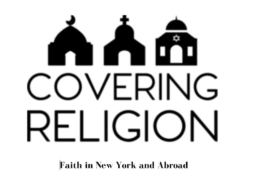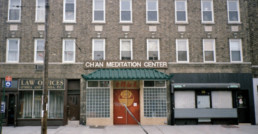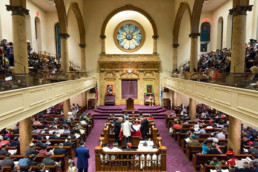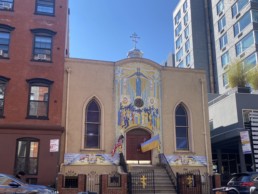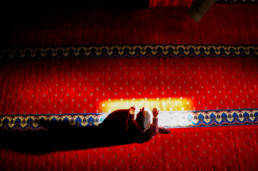A New Buddhist Ritual: Chanting Online to Release the Souls of the Dead
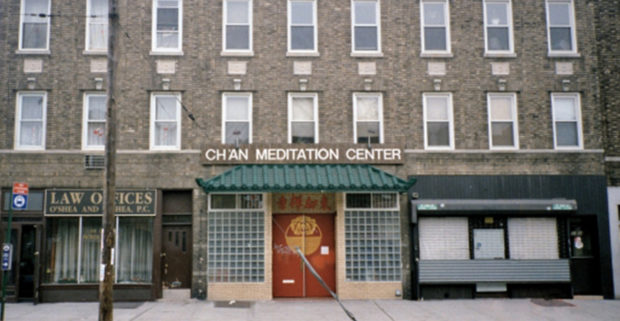
A Buddhist passed away in New York City.
His funeral was two weeks ago. Only a limited number of family members were allowed at the scene because of the pandemic. Master Chang Xun and her “householders” from the Chen Meditation Center in Queens were unable to attend, so they decided to go online and chant with the family at the funeral service. Buddhists believe that the soul can be released from purgatory through religious changing.
The long-distance chanting at the funeral was only one way that the Chen Meditation Center, located at Corona Ave in Queens, has been coping with the pandemic that swept through the globe over the last two years.
Chan Meditation Center in Queens, New York City. Photo courtesy: Chan Meditation Center’s official website.
At first, the center, like many other houses of worship, closed its doors. It gradually resumed its regular activities by holding hybrid classes and services, both online and in-person. On Sunday evenings, about a dozen members gathered in their temporary “Bodhimaṇḍa”, a place of enlightenment for Buddhists to sit down and meditate, which usually has one or more Buddha statues in it to watch the 2020 movie “The Father”–and discussed it after the screening. The film, starring Anthony Hopkins, is about an aging man who must deal with his progressing dementia. Half of the members sat in a circle, talking, while others were busy preparing homemade marshmallow cookies beside the window. At the end of the hall, a golden statue of Buddha sat quietly, staring at people from on high. A robot vacuum wandered leisurely on the floor below his feet.
Chang Xun said that online classes have actually increased the center’s audience. “Around 70 to 80 people attend online classes and meditations,” Chang Xun said. “Comparing to 30 people in the old days when we were meeting in person.”
Ming Shi, a householder at the Chen Meditation Center, said that online Dharma classes allow her to listen to different Master’s classes from different places. “We invited Master Sheng Dian’s disciple in Europe to discuss Dharma this Sunday since there are no geographical restrictions online.”
However, Masters, householders, and other participants are all hoping the activities can soon resume in person, especially because of the lack of empathy when talking online. “We cannot see each other’s facial expression clearly”, said Chang Xun. She’s also concerned that online classes have a strict time limit of one hour, while they can go longer when meeting in person.
Shi, as one of the organizers of young Buddhists’ classes in the New York area, worried about how sincerely young Buddhists can learn from online classes and chanting: “I don’t feel elderly Buddhists affected by the online classes very much. Young people did. Because there are lots of distractions in your life. if you are physically going to the meditation center and learning with others, you don’t have the chance to do other things, but you might do other things simultaneously when learning online.”
Despite online classes, Master Chang Xun must also cope with the lack of volunteers in the center during the pandemic. Usually, some familiar participants and householders in the center served as volunteers to cook vegetarian meals, do cleanings, and organize events, but during the pandemic, some volunteers cannot come to the center very often. Chang Xun herself had to take all their jobs.
That wasn’t too bad until one day she had to go to the market.
Chang Xun, like many Buddhists, is a strict vegetarian. She accidentally walked through several meat stalls in the market to get to the stalls that sell vegetables. She smelt the odor of fish and meats, and can’t stop thinking about when they were still alive. “I almost cried,” She said. “I can’t stand their suffer.”
The day after she had come back from the market, Master Chang Xun still thought about these creatures, even when she was teaching Dharma classes. “I can still smell them,” she said. She made a special prayer for the livestock she encountered at the market.
Now, Chang Xun seemed not to have to struggle anymore. Volunteers are coming back these days as the positive cases in New York started decreasing. The center expects more volunteers to come back in the following month.
However, their coping moments never cease. To Buddhists, Dharma itself is the way that they are trying to cope with any new situation in their lives–Asian hate crime, diseases, kindness, wars… etc.—even though this situation seems to violate their belief.
The Meaning of Purim, the Jewish Identity
On Saturday evening, the Orthodox Jewish community of the Congregation Kehilath Jeshurun gathers in the Synagogue to close Shabbat with a Havdalah blessing.
Halfway through the service, one rabbi gives a pre-printed source sheet to each synagogue member. Rachel Kraus leaves her seat in the women's section and steps to the front of the synagogue audience. She cautiously removes her face mask to make her voice echo throughout the room as she adjusts her long dress and begins the sermon.
She encourages the faithful to use the 30 days between now and Purim to reflect on the nuances of the holiday. Purim is the 15th day of Adar and is a holiday for Jews to be happy. According to the book of Esther, in the 5th century BCE, the Jews survived after the Persian rulers ordered to kill them, and Purim was the day when they celebrated their salvation.
Kraus vigorously explains to the congregation her interpretation of Purim and what this holiday indicates about Jewish identity. To do so, she uses 13 texts that are listed on the source sheet.
"Just as with the beginning of Av, rejoicings are curtailed, so with the beginning of Adar rejoicings are increased" (Talmud Masechet Ta'anit 29a). This is the first source in Kraus' collection. She explains to the congregation that Purim contrasts with the month of Av, which represents disruption and is seen as the lowest and saddest time in Judaism. Both temples in Jerusalem were destroyed during this month, and other calamities struck the Jews.
On the contrary, Purim is a happy and festive day. However, Kraus mentions that there are phrases and passages in the biblical and historical Jewish texts where this day does not seem so happy. The question, then, is whether Purim is a joyful day or not. Kraus answers that it is both, and it is a moment when we need to take a deep look inside ourselves.
According to Kraus, one must use the month of Av as a counterpoint to make the best of the day of Purim and be happy. The believer is called upon to understand whether they are giving attention to the right things or taking the wrong path. She says that this idea also defines Jewish identity as a community that always looks to its past to know how to face the future; "These days of Purim shall never be repealed among the Jews, and the memory of them shall never cease from their descendants." (Esther 9:28) Jews must always have their entire journey in mind. "(Purim) Help us go in the right direction," says Kraus.
The congregation listens in respectful silence to Kraus' words. Everyone is seated with their gazes turned toward her. This is one of the only moments when no one speaks or prays simultaneously, as it sometimes happens during the intonation of the hymns.
Even the children who usually do not actively follow the evening services are now sitting and listening to the young woman's words in front of the congregation, who encourage the faithful to reflect. There are about 50 men and a dozen women in the synagogue, and they all follow closely, nodding when they recognize themselves in Klaus' explanations of the Talmud.
Kraus ends her sermon; Purim is not just a happy holiday. It is a day when the faithful reflect on their past to make the right choices in the future. "When we forget where we come, we forget where we go," she recalls.
The congregation thanks Kraus by saying "Shabbat Shalom," and she returns to the midst of the women, who greet her with congratulations.
The faithful pass around the Havdalah spice box, and each member of the congregation sniffs it to give themselves energies for the next week until the following Shabbat. The rabbi blows out the candles. The service is over, and with it, the Shabbat.
Shuckling In A Modern Orthodox Synagogue
I do not know what time it is when Cantor Chaim Dovid Berson begins to sing the Amidah, or Shemoneh Esreh, which is the central part of the Jewish prayer. It is a prayer recited three times a day - morning, afternoon and evening - in Orthodox Jewish communities.
On this Friday evening, I attend Ma'ariv, the Jewish service recited after the sunset. I am in the Orthodox Jewish synagogue of Congregation Kehilath Jeshurun, located at 125 E. 85th St. on the Upper Eastside of Manhattan. No cell phones or other electronic devices are allowed here; that's why I don't know what time it is. This is a sacred place where the faithful share a moment of prayer with the community, and I understand that cell phones would distract people from this purpose.
Men and women sit separately in the synagogue, and I join the few women present. It is the first time I have ever visited a synagogue and the first time I have ever attended a service. I look around. The men are dressed in a jacket and tie and wear the kippah, a brimless cap worn as a sign of respect. The women are elegantly dressed. The rabbi is in the center of the room on the bima, a raised platform. He chants and the rest of the congregation sometimes joins the intonation of the hymn.
When the prayer intensifies, and voices rise, the faithful begin to rock. The hands either go down the body or hold the prayer book; the feet are stuck to the ground. Some go back and forth, some go from side to side, and some make a deep bow at the end of the swaying motion. This movement is called “shuckling,” which comes from the Yiddish word that means "to shake." It is a profoundly private moment between the faithful and their prayer, and each person takes as much time as they need to make this movement.
While the faithful continue to shuckling, I observe them in silence. It almost seems like I can see the energy pouring out of their bodies and pervading them. Quickly, I realize that there is not a time when the worshippers are called to make that movement. The person begins to rock back and forth at their discretion, when they want to, and without needing someone to tell them to do so. Everything seems spontaneous and authentic.
Next to me, a girl named Mia is particularly focused in prayer as she moves her body back and forth, occasionally making a deep bow. At the end of the service, she tells me that that movement is her way of praying, and there is no precise explanation behind this gesture.
According to Rabbi Chaim Steinmetz, the swinging represents the total immersion of the believer's energy in prayer. He also jokingly tells me that it is a movement-related only to Jews, particularly Orthodox Jews, and that the Prophet Mohammed is said to have warned his adherents "not to do like Jews who move back and forth."
There is also another explanation of shuckling that can be found in the past, according to an article written in 2013 by Miriam Goldmann, curator of the Jewish Museum Berlin’s exhibition “The Whole Truth.” In the 12th century in Spain, Rabbi Yehuda Halevi reported that often the Torah was read by many men at the same time. To ensure that the process was quick, they developed this movement whereby they would bend forward to see the book and then quickly retract to make room for the faithful afterward.
However, the service is now over. I gather my things and present myself to the rabbis. Meanwhile, the community members greet each other by saying "Shabbat Shalom," which is an invitation to enjoy a blessed Shabbat. I greet everyone by thanking them, and as a response, I receive a warm "Shabbat Shalom, Eleonora.”
Anxious East Village Community Prays for Relatives Back Home in Ukraine
Among the worshipers at All Saints Ukrainian Orthodox Church in Manhattan on Sunday, Tetiana Geletei prayed fervently for her father.
Geletei’s whole family is in Ukraine, where her father has been called by the Ukrainian army to fight the Russian invasion. “I cannot connect to him,” she said. “I don’t know where he is now. Is he safe?” Her pitch rose as she voiced her last worry: “If he has something to eat at all.”
At the service, Pastor Vitaliy Pavlykivsky urged congregants to pray for Ukraine and to donate money to support the Ukrainian army. The church is located at 206 East 11th Street in the East Village.
A flier on a table near the prayer candles for sale at the church’s entrance listed a bank account and routing number for donations. “Ukrainian National Federal Credit Union has open account: ‘Help Ukraine’ for the Armed forces of Ukraine. Collected funds will be wired every day to support Ukraine,” it read.
At the end of the formal part of the service, when Pavlykivsky had blessed each of the worshippers individually, Iryna Rusyn, 22, asked where she could donate money to support the army. She’d brought cash with her.
Rusyn had spent more than an hour traveling to the church by train from Queens, she told me outside afterwards. She doesn’t have time to make the journey every Sunday. In fact, she’d only been to All Saints once before. But she needed to be there this week.
“I felt that I needed to pray for my country, for my people,” she said on the church steps, hands stuffed into the pockets of her long black faux fur coat. Despite the cold, she’d made plans to meet up with a friend, a fellow Ukrainian, to go to a rally in support of their homeland.
After she had left, most people still lingered in the church. “Because of this event, of course they pray a bit longer now,” she explained.
Inside, children ran from side to side along the back aisle and bounded up and down the stairs to the balcony where some of their mothers were singing in the choir. Four kids wore the colors of the Ukrainian flag, which flew outside the church door.
The mood among the adults was somber and anxious. One woman wiped her eyes repeatedly during prayers. She hastily stepped outside twice to take calls on her cell phone, pressing it to her ear before she’d even reached the door.
Geletei, 30, a human resources coordinator, is here in the United States by herself. She described the how church’s atmosphere felt changed: “It’s different because people are hurt.”
The president of the church, Oleh Mykulynskyy, had left New York for Ukraine that morning, Geletei said.
“He served [the] Ukrainian army before he came to the United States. So he felt like he needs to go back and try to help,” Geletei said.
As the whole church prayed for Mykulynskyy, his wife sang upstairs with the choir, as she does every Sunday.
“When we found out that he left, half of the choir was crying,” Geletei said.
Rusyn was not the only person who came to support the church community because of the ongoing crisis. Pavlykivsky greeted a small group of Georgians in English and thanked them for their prayers and support, and a young woman named Samantha whose grandparents had belonged to the church after they had immigrated from Ukraine visited for the first time. But for members, being together was emotionally intense.
“It’s really hard to be here. It’s really hard,” Geletei said. “Because, you know, you can feel the pain.”
“Praying helps,” Geletei said. “And all this long prayer at the end, it was specifically regarding the war. So we were praying for stopping the war, we were praying for strength for Ukrainians.”
Engraving God Upon the Heart
The act of engraving is deliberate, repetitive, and slow. It takes time to form even a crude surface outline, to say nothing of making it presentable, or even beautiful. You must make the same motion over, and over, and over (and over) again, patiently taking away a small piece of material each time. It becomes trance-like. But you must remain focused on the task, and not be robotic in your actions. No matter when you finish, there is the feeling that you can refine it, sharpen the image, remove some abstraction from your finished artwork.
The act of engraving the name of God upon your heart is no different to the Sufi.
Sufism is a branch of Islam that emphasizes spirituality and mysticism. Having a close and loving relationship with the Almighty is one of the chief goals of the Sufi, beyond just slavishly following the divine laws set forth in the holy books. It is a deliberate act to embrace Him.
The Naqshbandi Order of Sufism derives its name from two Farsi words, first “to engrave” (naqsh) and then to form a bond “bandi.” According to Madani Sheikh, a devotee of The Most Distinguished Naqshbandi Sufi Order of New York and New Jersey, this refers to carving the name of God upon the heart of the Sufi while forming bonds back to their spiritual teachers (called Mawlana, “Our Master”).
In order to carve the name of God onto their hearts, Sufis sing chants and meditate upon the words they hear, over and over and over again. One of the hymns they sing, The Opening Qasida, has 24 verses that each begin with “Yā Rabbi sallī ‘alā Muhammad” (“O Lord, bestow blessings upon Muhammad”). Another is 64 verses long, and takes over 10 minutes to sing.
A unique part of the Sufi worship is done towards the end of the service, after the night prayers are finished. Worshippers form a ring on the rugs they have carefully laid out on the floors, facing each other. As with all other parts of the service, the women and men sit separately. The faithful close their eyes, cross their legs, and place their open hands upon their knees, palms facing upwards. They wait silently, patiently, for their leader, Shaykh Diomande Soulieyman, to begin the chants.
At Soulieyman’s direction, Sheikh stood up, walked over to the light panel, and darkened the room. Only a few lights in the massive space were left on, just enough to illuminate the exits. The Sufis were shrouded by the darkness.
Soulieyman began to sing. He sung minutes-long verses that repeated four or five times apiece, his tone rising and falling. In the dim light, the Sufis swayed gently in time to his melodies. As the Shaykh sung into his microphone, connected to a powerful sound system, his followers could hardly be heard singing alongside. On the rare occasion he takes a breath though, their voices come through clear and harmonious.
The air of the darkened room was filled with their meditative chants. It did not matter that there were only 30 Sufis here, nor that they had to worship in an Episcopal Church on 28th Street because they had no Mosque of their own. It did not matter. For the moment, this was not a place of pulpits and altars, not one of a small community in a big city, not even one of sight. This was a place for God.
After 45 minutes, the chants slowly faded out with a long, mournful note. Sheikh quietly rose again and turned on the lights, which felt almost jarring after the extended trance of the meditation. The worshipers took each cupped their hands and brought them to their face as if splashing themselves with water. They had received God’s blessings through their meditation, and were spreading His gift over their skin.
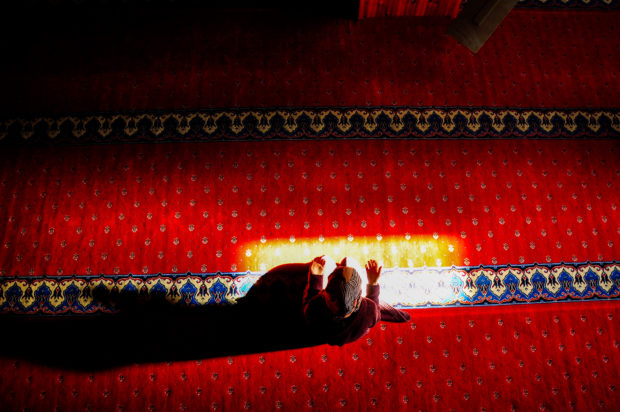
Soulieyman delivered a brief sermon, less than 10 minutes long, and everyone rose from their seated position. The service was over, and now it was time to share a meal.
They shared kabobs and lentil soup with lamb, drank a pineapple-ginger juice popular in West Africa, and chatted about life. They hadn’t been able to meet the week prior due to a snowstorm, and a few of them commented on how pronounced the absence felt after just a week. After such a powerful, transcendental experience in the dark, it’s hard to imagine missing even one service. The engraving on their hearts was made a little deeper that evening.
